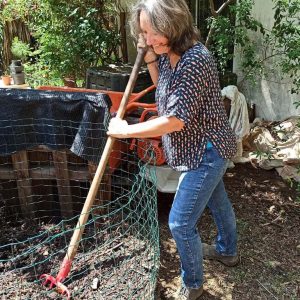The production of our own charcoal
After we had already used and tested a smaller amount of charcoal the previous winter, we decided to produce this winter a large amount of charcoal was to be producedthis winter.
We beganThe preparations started already in October with by the sorting of the available wood. Depending on the thickness, the branches accumulated from pruning were sorted:, very thick for firewood, thick for the chipper and thin for charcoal production. Thin wood is anything that can be broken by hand;, it was broken into palm-sized pieces and then stored in bags in a dry place.
For the next step, we cut an old oil drum was cut to the right size and placed it in a location that was clear all around to reduce anyso that the risk of fire hazard was prevented. ThenNow, a garden hose was prepared to extinguish any ignitions that might occur, or to regularly wet the area around the barrel as a preventive measure.
The prepared branch pieces were now charred in layers in the barrel. To do this, a small fire was lit in the barrel, and as soon as the branches were covered with a layer of ash, i.e. became whitish, the next layer of branches was added. We did tThis was done continuously until the barrel was full. Adding the new layers at the right time prevented the layer underneath from burning, as it was deprived of oxygen when the new layer was ignited. The last layer then burned until it too was covered by a fine layer of ash, and then we extinguished the whole barrel was extinguished with water, thus abruptly ending the fire. The wood was now black throughout, i.e. charred.
Next, the contents of the barrel were emptied out onto a sunny clean surface to dry. After a few days with the help of the warming sun, the coal was dry enough and ready for the next processing step. This coal, after all, still had the shape and thickness of the broken branches and was thus still too thick for further use. It needed toshould become much smaller and finer.
Next, we placed the dried charcoal was poured into the mixing machine in portions, along with a good amount of large round pebbles. In it, the coal was now ‚tumbled‘ for quite some time until it was relatively finely crushed. Then, we put this fine coal was filled into large buckets.
We then layered tThe charcoal prepared in this way is then layered into the new compost heap in the next step. There, as is the nature of charcoal, it will soaks up the nutrients that form in the compost during the ripening process. At the same time, this fine charcoal – thanks to its porous surface – will offers itself as an ideal living space for all kinds of microorganisms. The charcoal is thus charged during the longer maturing process of the compost heap.
In the following autumn/winter, the charcoalit is then spread on the field soil together with the compost. There, over the course of the year, it is then worked into and mixed with the arable soil by the soil organisms. The following year the same process is repeated, and so on….
Thus, over the course of many years, ‚Terra Preta‘ -– black soil -– iis slowly but surely created! With each new addition of compost / charcoal, the soil becomes darker and darker and, at the same time, the soil becomes more and more enriched with charged charcoal. Once incorporated into the soil, the charcoal can now unfold its beneficial effects and release the substances and microorganisms charged in it very slowly and evenly into the soil.



